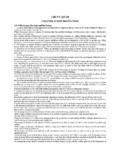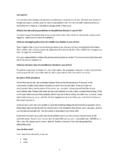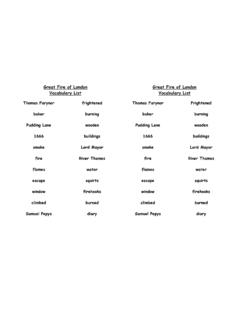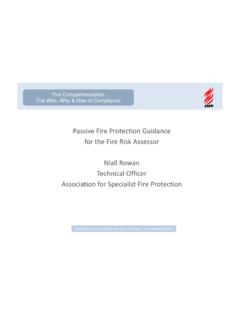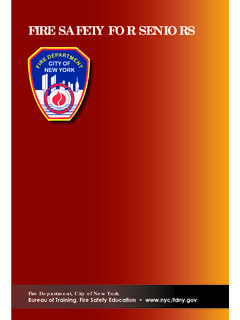Transcription of Fire Safety Log Book - Safety Management (UK)
1 fire Safety Log book Company .. Address .. Responsible Person . Competent Person . Date Started . For Additional Information: Safety Management (UK) Ltd Holme Suite, Clawthorpe Hall Business Centre, Burton in Kendal, LA6 1NU. Tel: +44 (0)1524 784356 e-mail LOG book . INTRODUCTION. This log book is designed to assist you in complying with the Regulatory Reform ( fire Safety ) Order 2005. with the recording the testing of fire Safety features and equipment contained within your premises along with a programme of fire Safety training for your staff. The information contained is for your guidance only and should form part of your fire risk assessment, also required by the Regulatory Reform ( fire Safety ).
2 Order 2005: The Log book will guide you as to the current intervals of Inspection and Maintenance for the Equipment and fire Safety Training CONTENTS OF LOG book . General fire Safety Staff Training Visiting Enforcing Authorities fire Risk Assessment fire Alarm Systems fire Instructions and Drills Record of Instruction and Drills fire Extinguishers Record of Test and Inspections Hose Reels Emergency Lighting Record of Tests and Inspections Miscellaneous Equipment Record of Tests Escape Route Audits USEFUL TELEPHONE NUMBERS. Name Company Tel No Mobile No GENERAL fire Safety . HEATING. Keep boiler houses clear- do not use them as an extra storeroom.
3 Keep portable heating appliances away from furniture and any combustible materials. SMOKING MATERIALS. Be vigilant in areas where people smoke and provide adequate ashtrays. Before leaving rooms which will be unoccupied for long periods, or in which persons will be sleeping, make a final check for any cigarette ends. These may have fallen into the recess of an armchair, on the carpet or on the bedclothes when someone fell asleep. Always empty ashtrays. WHEN YOU CLOSE DOWN. Go round the premises at the end of the working day or end of a shift. Check that electrical appliances are switched off and that there are no smouldering cigarette ends. Close all doors and windows so that if, in spite of all your precautions, a fire does break out, it will be confined in a small area.
4 Lock up securely GENERAL fire Safety . Be aware of the common fire causes Electricity It is a source of heat. Get faults repaired immediately by a competent electrician. Do not overload sockets. Switch off appliances after use. Rubbish fire loves rubbish. Get it out of the premises and into metal bins (with lids) away from the building as quickly as possible. Smoking Still the most frequent fire starter. Consider instigating a "No Smoking" policy. Heaters Portable heaters start fires if not placed carefully and used wisely. Dangerous Goods Some cleaning materials and aerosols are either flammable or explosive. Keep them all well away from any source of heat.
5 The careful use and storage of any flammable liquid or gas is essential to maintain a safe working environment. Arson Help to protect your premises from the arsonist by locking away any flammable liquids or gases. Secure your premises at the end of the day, including doors or windows that are easily missed. Hot Work Activities such as welding, flame cutting, use of blow lamps or portable grinding equipment can pose a serious fire hazard and need to be strictly controlled when carried out in areas near flammable materials. This can be done by having a written permit to work for the people involved (whether they are employees or a contractor). IN THE EVENT OF A fire .
6 Make sure your staff know: How to raise the alarm and call the fire and Rescue Service (place written instructions in prominent places);. How to use fire extinguishers;. Where the escape routes and assembly points are. STAFF TRAINING. fire DRILLS. Should be carried out at the interval shown below and conducted to simulate fire conditions; one route obstructed. No advance warning should be given, other than to specific staff for purposes of Safety and the avoidance of a false call being made to the fire and Rescue Service. SIX MONTHLY. In residential premises, places of entertainment, large shops and department stores. YEARLY. In industrial and commercial premises.
7 Date Nature of Drill Persons/Sections Evacuation Person in Signature Taking part Time Charge Date Nature of Drill Persons/Sections Evacuation Person in Signature Taking part Time Charge VISITS BY fire Safety OFFICER / ENFORCING AUTHORITY. Date Inspecting Officer (Print) Officer's Signature Comments fire RISK ASSESSMENT. A fire Risk Assessment is an organised look at what, in your work activities and workplace, could cause harm to people. This will allow you to weigh up whether you have taken enough precautions or you should do more to avoid them. The important things you need to decide are whether a hazard is significant and whether you have covered it by satisfactory precautions so that the risk is acceptably low.
8 What do the terms "hazard" and "risk" mean? A hazard is something that has the potential to cause harm. A risk is the chance, high or low, of that harm occurring. Before you start your risk assessment Regardless of any previous approval, ( fire Certificate, licensing or building legislation) you still need to carry out a fire risk assessment. However, if the previous approval covered all the matters required by the fire Regulations, and conditions have remained unchanged, numbers of people present, work activity etc., then your fire risk assessment may well show that few, if any, additional precautions are needed. Your risk assessment may identify additional matters which need addressing if the previous approval was given according to an out of date standard of fire precautions, or the approval was under legislation which does not cover all the requirements of the fire Regulations.
9 If you are not sure, the fire authority will be able to advise you. How do you do a fire risk assessment? A fire risk assessment will help you determine the chances of a fire occurring and the dangers from fire that your workplace poses for the people who use it. The assessment method suggested shares the same approach as that used in general health and Safety legislation and can be carried out either as part of a more general risk assessment or as a separate exercise. For fire risk assessments there are five steps that you need to take Step 1 Identify potential fire hazards in the workplace. Step 2 Decide who ( employees, visitors) might be in danger, in the event of a fire , in the workplace or while trying to escape from it, and note their location.
10 Step 3 Evaluate the risks arising from the hazards and decide whether your existing fire precautions are adequate or whether more should be done to get rid of the hazard or to control the risks ( by improving the fire precautions). Step 4 Record your findings and details of the action you took as a result. Tell your employees about your findings. Step 5 Keep the assessment under review and revise it when necessary. If your workplace is in a building shared with other employers, you and all the other occupiers and any other person who has control of any other part of the workplace will need to discuss your risk assessments. This will help to ensure that any areas of higher risk, and the need for any extra precautions, are identified.

